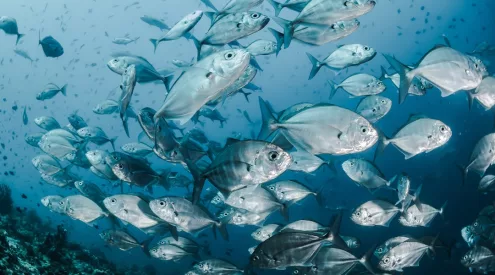Giraffes have interesting blotches and leopard rosettes are beautiful, but nothing in the animal world equals the showy dazzle of a zebra. It’s frankly outrageous. In the slow, remorseless workshop of natural selection, every part or process of every living thing is there because it gave that species a survival advantage. Whatever advantage selected for a horse with striped pyjamas?
There’s an old African folk tale that tells it this way: Long ago, when animals were still new on Earth, the weather was very hot and what little water there was remained in small pools. One of these was guarded by a proud old baboon.
‘I am the lord of the water,’ he said when other animals came to drink. ‘You may not have my water.’
One day, a pure white zebra came down to the pool to drink (in those days all zebras were white). The baboon, who was sitting by his fire, jumped up. ‘Go away,’ he barked.
‘The water is for everyone, not just for you, monkey-face,’ said the zebra.
‘Oh yes?’ the baboon responded. ‘Then you’ll have to fight me for it.’
The baboon rushed at the zebra and soon they were locked in fierce combat. Finally, with a mighty kick, the zebra sent the baboon flying high into the rocks of the cliff behind them. He landed with a smack on his backside and today it’s still hairless from the abrasion.
But the zebra, dazed from the battle, staggered and fell into the baboon’s fire. Being too tired to get out quickly, the logs on the fire scorched him, leaving stripes across his white fur. The shock sent the zebra galloping away to the plains, where he has stayed ever since.The baboon and his family, however, remain high up among the rocks where they bark defiance at all strangers and hold up their tails to ease the smarting of their bald patches.
There have, of course, been other explanations for the stripes, though not as dramatic. One has been camouflage, the idea being that zebras can’t be seen in tall grass or in bush. But other than mountain zebras, most of the species are plains animals and spend much of their time in short grass away from trees where predators hide.
A rather better explanation is that, since zebras are herd animals, the stripes might confuse predators. A lion would have trouble picking out a single zebra from a herd fleeing in front of it. Another possibility is that zebras are like snowflakes, each with an individual pattern. This is how they recognise each other and, in particular, how foals can find their mothers in the herd. I guess you could call it natural barcoding.
Finally, though, a team of biologists decided to stop speculating and run some scientific tests. They’ve come up with a completely different hypothesis: the stripes appear to be a bug repellent.
Horseflies are appropriately named. They’re noisy, extremely agile and if you’ve ever tried to swat one, you’ll know they’re as tough as boot leather. They simply straighten their antennae and fly off intact.
Their razor sharp mandibles slice the flesh, allowing the female horsefly to sup on blood, which is necessary for her reproduction. The bites often become itchy, causing discomfort and distraction to the grazing herbivore. Horseflies are also vectors for blood-borne pathogens such as equine infectious anemia virus, parasitic filarial worm and even anthrax.
If an animal is attacked by a swarm of horseflies, it can lose up to 300 millilitres of blood a day, weakening it and possibly causing death from blood loss.
Gábor Horváth, Susanne Åkesson and colleagues from Hungary and Sweden didn’t have zebras in mind when they began a study on the annoying insects. They simply wanted to know what colours attracted them. To do this they painted fibreglass horses in various colours, coated them in oil and insect glue, then placed them in a field to await results. Every two days they plucked the trapped flies from their ponies and counted them.
It turned out that dark colours attracted most flies, white attracted fewer, but to their surprise a model they’d painted with zebra stripes attracted fewest of all. They discovered that horseflies respond strongly to polarised (single-plane) light – many insects do – and that stripes confused the light waves.
‘We started off studying horses with black, brown or white coats,’ said Åkesson, from Lund University. ‘We found that from black and brown horses we get horizontally polarised light. This effect made the dark-coloured horses very attractive to flies. But striped horses weren’t. That was a surprise because, in a striped pattern, you still have these dark areas reflecting horizontally polarised light. But the narrower (and more zebra-like) the stripes, the less attractive they were to the flies.’
Selection would have gradually favoured semi-striped pre-zebras, which remained healthier and perhaps the semi-striped quagga was a way station that survived until humans shot it to extinction.
It’s a less lyrical reason for stripes than a battle between a white zebra and a grouchy baboon. But if stripes also deter the horsefly’s nasty cousin, the tsetse fly (someone needs to do the science) there’s an idea just waiting for a sharp entrepreneur. Safari clothing could see a shift from drab khaki to something more dazzling.
The study on horseflies was published in the Journal of Experimental Biology, 1 March 2012.
















